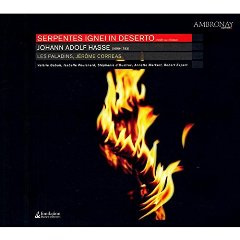Hasse - Serpentes Ignei in deserto (2006)
Hasse - Serpentes Ignei in deserto (2006)

1.Introduzione 2.Rezitativ Eliab und Eleazar 3.Arie Eliab 4.Rezitativ Moyses 5.Arie Moyses 6.Rezitativ Josue 7.Arie Josue 8.Rezitativ Angelus und Moyses 9.Arie Angelus 10.Rezitativ Nathanael 11.Arie Nathanael 12.Rezitativ Eliab, Eleazar und Moyses 13.Arie: Eleazar 14.Rezitativ Angelus und Moyses 15.Arie Angelus 16.Rezitativ Josue und Eleazar 17.Duett Josue und Eleazar 18.Rezitativ Moyses 19.Arie Moyses 20.Epilogus Valérie Gabail - Angelus (soprano) Isabelle Poulenard - Josue (soprano) Stéphanie d'Oustrac – Eliab et Nathanael (mezzosoprano) Annette Markert - Moyses (contralto) Robert Expert - Eleazar (countertenor) Ensemble Les Paladins Jérôme Correas – director
One of the most performed composers of the eighteenth century. Hasse bridges the gap between the baroque and the classical. His oratorio Les Seprents de feu dans le désert is a perfect example of this. ---ambronay.org
First of all, this not too long oratorio by Johann Adolf Hasse (78 minutes) was done for women singing and in Latin language. Because of that, there are only high voices,included that of a countertenor,that fit nicely with all the women. This oratorio is a showpiece for the voice, all the singers (the countertenor Robert Expert, Michelle Poulenard,Annette Markert,Valerie Gabail and Stephanie D'Oustrac) are outstanding, but I loved most the arias sung by Stephanie D'Oustrac, because they were the "dramatic" ones, in my opinion. This work is strange in the way that if you hope find melodies that reflect strong and emotive feelings,like the title sugests(Serpents of fire in the desert), there are only the mentioned above, in two diferent roles by the singer(Eliab and Nathanael)and in the recitatives.But the rest is of a lyrical beauty that betrays its name. That means if you expect something "fiery" you will not find it,but you will find some of the loveliest melodies and singing in an oratorio in the baroque,apart of their difficulty, vocal ornamentation and length,being the arias of the "da capo" kind,(e.g., once finished,it begins again with the first verse). The orchestra plays in period instruments splendidly,that is 1736-39,with no exact date of composition. It is a very good way to know another "german" composer that could compose in the best "italian" style, giving us proof that not only Handel learned that craft at the highest level. It is a pity we can hear only a small output of this legendary composer,a worthy contemporary of Handel. The CD comes with libretto in latin with french and english translations, so you will know the biblical history that gives the name to this masterpiece. ---DaDomingo Warner, amazon.com
download (mp3 @320 kbs):
yandex mediafire uloz.to mega 4shared cloudmailru gett








